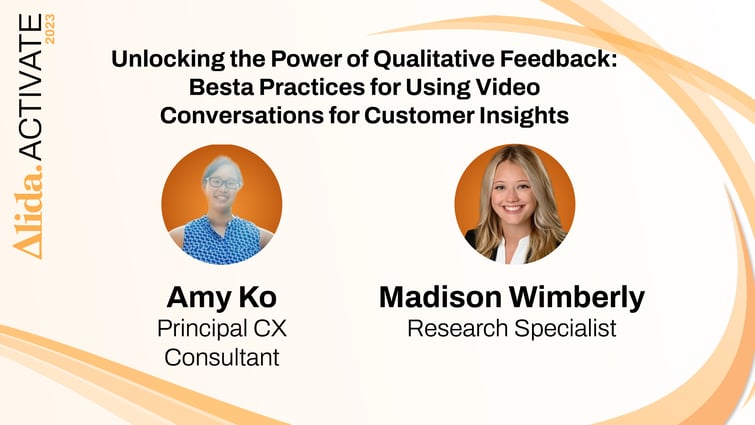Video conversations deliver the qualitative insights your organization needs to better understand your customers’ thought process and respond to their needs and wants.
Video and qualitative video feedback are essential to understand how to deliver better experiences and products. As a pioneer in the market, Alida Video Discussions has helped thousands of brands fuel their business with rich qualitative insights, giving them a competitive advantage.
Qualitative feedback helps to provide more detailed insights into customer experiences, needs and wants. By using video feedback, businesses can identify customer trends, pain points, motivations, and preferences, as well as develop better products and services. Additionally, video feedback can help businesses uncover hidden insights that may not be revealed in traditional surveys or interviews.
As competitors are just now trying to catch up, businesses should take advantage of the more mature and fully developed Alida's Video Discussion tool and qualitative feedback to stay ahead of the competition and deliver the best possible experiences and products to their customers.
Why are video conversations so important?
The study of customer experience has been fixated on voice of customer (VoC) for the past decade. Video conversations provide visibility into more than VoC. Through this tool, companies can better understand emotions and dive deeper into thought processes and feelings. It also gives researchers the opportunity to ask in-the-moment follow-up questions.
The technology behind video conversations has evolved to the point that research-focused AI can help analyze and synthesize the rich data obtained into something more digestible.
Why use video conversations?
There are immediate benefits to using video conversations to conduct qualitative research.
- Save time
- Faster speed to insight
- Enable access to a wider sample pool (since activities are conducted virtually)
Some organizations use conference calls to conduct their research. While cost-effective, the interviews vary in quality and are painstaking to analyze, leading to additional time and resources wasted.
The video conversation software allows for a moderator to facilitate the process, and tools for researchers to message the moderator as needed, tag in-the-moment clips for a later date, and take notes while the session is in progress.
Once the interview is completed, you’ll have access to recordings, transcriptions, and the tools to create a highlight reel.
What’s the best methodology for my research?
Video conversations are the perfect tool for a deeper dive into individuals’ thought process and to ask in-the-moment follow-up questions. The tool gives you unfettered access to your customers’ reactions and expressions (live and on tape).
You have multiple options to conduct these conversations:
In-depth interviews (IDI)
In an IDI, a moderator speaks directly to a single customer for 30 minutes to one hour. It’s the best option for deep diving into the decision-making process, preferences, experiences, and motivations of the person you’re talking to. This intimate setting is ideal for sensitive topics that some individuals may be reluctant to share in a group. These interviews build trust and get less biased opinions.
Since there’s only one participant per interview, findings may take a longer time to report.
Focus groups
This methodology involves a larger group of between 5 and 12 participants plus a moderator who facilitates the conversation. These focus groups can last longer than an IDI (90 minutes on average). This format is recommended when you want to hear multiple perspectives in a short period of time, encourage debate, or spark new topics and ideas. Focus groups are also well suited to tackle broader exploratory topics.
Dyad or triad
This approach allows multiple voices to be heard at once (two to three) but in a much more intimate setting. The methodology enables the moderator to dive deeper into each topic.
Do I need a moderator?
Moderation is a skill that professionals develop over time. Understanding body language, coming up with off-the-cuff follow-up questions, and getting participants to stay on topic is no easy task. With Alida’s Video Discussions, you would work with a professional moderator to ensure you’re getting the right and most valuable insights.
Video Discussions lets observers sit in a backroom, listening in on the discussion, and guide the moderator with suggestions or areas of focus while the interview is occurring.
What are the best practices for recruiting?
Before recruiting: You must identify the type of individuals you’re looking for. This will ensure there are measures in place to speak to the right people. Aside from specific attributes, consider the demographic information (age, gender, geography). Using your community’s profile variables can get you over this hurdle.
You must also decide if you’ll provide an incentive to participants: an effective way to ensure they’ll show up to the interview is by proving to them they’re valued. A higher incentive may be required if you’re reaching out to more specialized segments (professionals, executives).
While recruiting: You can recruit from your Alida Community, or you can work with a vendor. It’s important to have a verification process in place over the phone or via screener to ensure you’re getting the right people in the room.
Set expectations upfront in terms of scheduling. For focus groups, it’s a standard practice to invite more participants than necessary in case of no-shows. For IDIs the recommendation is to have backups.
The more prep work you put before conducting the interviews, the more likely the conversations will be successful.
Get access to the on-demand sessions of the Alida Activate 2023 North America here.








